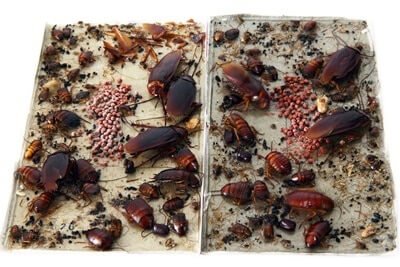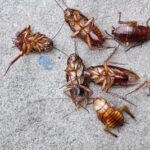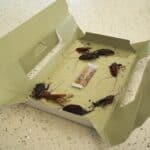An effective cockroach bait trap will kill the individual cockroach within 12-24 hours. This gives the cockroach that ingested the bate sufficient time to return to its nest to poison other colony members. You’ll notice a reduction in the overall cockroach population over the next 1-2 weeks.
Cockroach bait is mixed with insecticide. When consumed, the cockroach slowly dies. Then, other cockroaches will eat the corpse. One poisoned cockroach can cause a chain reaction as others will start to die off.
Other kinds of traps, such as glue traps, are good at catching individual cockroaches. However, they’ll do little to reduce a large infestation. Set up bait and dust traps around your home for faster results. Some will lure cockroaches into eating the poison, while others will coat them in insecticides that irreparably damage the exoskeleton.
How Effective Are Cockroach Traps?
Bait traps work best. They involve mixing an enticing food with insecticide, tricking the cockroach into ingesting it. When it eats the bait, it’s poisoned. However, poisoned bait doesn’t kill a cockroach immediately.
Instead, the cockroach will make its way back to the nest and die within 24 hours. The other cockroaches feast on its body and ingest the toxic insecticide. This causes them to also die over the course of the next 14 days. Even if you don’t know the nest’s location, a high-performance cockroach trap will reduce the colony’s size.
Bait traps work if the poisoned cockroach doesn’t return to the nest before it dies. That’s because the cockroach’s poop contains toxins. When it leaves droppings behind, these may be eaten by other cockroaches.
How Quickly Do Roach Traps Work?
Depending on the bait trap you use, the poison will kill the cockroach in 6 to 24 hours. It’ll then take 7 to 14 days before you’ll see a significant reduction in the number of cockroaches in your home.
It’s an effective way to kill off a large number of cockroaches. It relies on understanding what cockroaches need to survive and using their cannibalistic nature against them. According to North Carolina State University, the most effective traps contain abamectin and hydramethylnon. Most OTC cockroach traps contain:
- Abamectin
- Boric acid
- Chlorpyrifos
- Hydramethylnon
Even if you don’t know where the nest is located, cockroach bait is an effective DIY option.
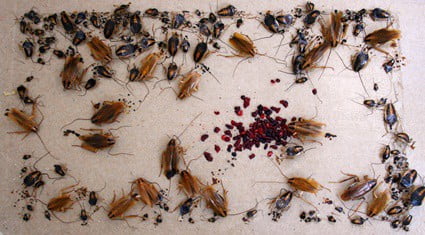
What Are The Best Cockroach Traps?
Some people dismiss cockroach traps as ineffective, but they may not understand how to set them up correctly. Randomly placing traps around the home is unlikely to yield the desired results. Here are the types of roach traps:
Gel Traps
Gels are useful for covering entryways to a cockroach nest. With a syringe, it’s easy to apply a small amount in multiple areas of the home. Gels are usually the most potent, fast-acting types of bait. Unfortunately, they dry out quickly.
Bait Stations
Bait stations are small plastic squares that have bait inside a circular container. These are safer when you have children and pets. After all, the toxic bait is hidden away inside. However, because the bait is closed off, it’s less potent than exposed bait. Also, the odor can’t reach cockroaches from afar.
Glue Traps
Glue or sticky traps are stripes of material with heavy glue on them. You can place them around your home so that cockroaches step on them and get stuck.
Much like insecticide spray, glue traps are a good way of targeting individual cockroaches. You’ll need to collect the trapped cockroaches and dispose of them. However, they’ll do little to kill off an entire nest.
Powders
Powder insecticides, such as diatomaceous earth, rely on cockroaches walking through them. It can:
- Attack the nervous system
- Dry out the cockroach’s exoskeleton
Some powder traps will give the cockroach time to return to its nest, and this dust will compromise others.
Best Place to Put Cockroach Traps
Once you’ve chosen the right kind of trap and know the cockroach you’re dealing with, you need to consider placement. This will be a deciding factor in how effective your cockroach trap is.
When placed in the wrong spots, cockroach traps don’t work. The cockroaches may walk past them and learn to avoid the insecticide. Cockroach traps should be arranged near nests and hotspots. Cockroaches like warm, dark, humid environments. Good locations for cockroach traps include:
- Behind refrigerators
- Under kitchen sinks
- Under bathroom sinks
- Behind stoves
- Cabinets
- Drawers
- Basements
- Attics
- Under water heaters
Near Nests
Any crevice should be considered an entry point. If you see a cockroach disappear into a gap in your wall, your cupboard, or under your fridge, put a trap there. They’ll notice the trap as soon as they leave the nest in search of food. They will also be hungry after emerging for the night instead of well-fed after retreating from your kitchen.
Places Where Food Is Removed
While it’s tempting to place traps near open food as a kind of double-bait, this is unwise. Cockroaches may ignore bait if there are more obvious food sources available.
Likewise, some cockroaches are capable of sensing pesticides. If they’re given the choice, they may choose the safer option. Gel baits may have an artificial smell that can’t compete with leftovers.
Clean up and properly contain all food in your kitchen. You should deep clean the house before placing any traps. Let the bait be the only thing the cockroaches are attracted to.
How Many Cockroach Traps Do I Need?
The number of cockroach traps needed depends on the severity of the infestation. A moderate case is when cockroaches are active at night. A severe infestation is when you see cockroaches during the day.
As nocturnal creatures, cockroaches avoid moving around when the sun is out, lights are on, and people are active. Daytime movement implies that the nest is so overpopulated.
- Moderate infestation: 12 traps
- Severe infestation: 24 traps
Do Cockroach Traps Attract More Cockroaches?
After setting traps around your home, you may notice there are more cockroaches than normal. While this may seem alarming, it’s a good thing. It means that the cockroaches are attracted to the bait and are leaving the nest to find it.
It’s natural to think the bait is attracting cockroaches from far and wide. Certainly, this only makes your infestation worse and fills your house with pests, right? Rest assured, those new cockroaches you’re seeing aren’t new at all.
Traps only attract cockroaches that are presently living in your home. You didn’t see as many before because they’re getting their food in a more discreet location.
Likewise, many cockroaches won’t be able to return to their nest and will die out in the open. When this happens, other cockroaches may eat the corpse.
How Long Do Cockroach Traps Last?
Cockroach traps last for different time periods, but they all need to be replaced occasionally. If you notice that the baits are being eaten and the traps contain multiple dead roaches, replace them more often.
Despite what the recommended expiration date says, your cockroaches are getting through them quickly. Over time, the baits will last longer, and the traps will capture fewer cockroaches as the colony reduces in number.
Gels
Gels need to be changed every 7 days if the cockroaches are consuming the content regularly. You can also swap out those that have dried out for fresh varieties.
Bait Stations
Bait stations should be changed once a month or when the liquid is depleted. This could be once every 2 weeks.
Glue Traps
Glue traps should be switched out every 4 months. Alternatively, change them whenever too many cockroaches have been caught. If you don’t, other cockroaches will know to avoid it.
Powder Traps
Powders remain effective when dry. However, in the earlier study from North Carolina State University, researchers tested the potency of certain traps based on how long they aged.
They tested 2 types of bait: a powder and a gel. They noticed that, as time went on, even the powder’s potency was reduced due to humidity in the air. Change out the powder once a month or when you notice fewer dead cockroaches.
Do Ant Traps Work on Cockroaches?
If you’ve had an ant infestation before, you may have ant traps you want to use. In theory, ant traps should work as well as cockroach traps because they use the same pesticides. However, ant traps are ineffective.
Many brands advertise themselves as made for both ants and cockroaches. However, there are differences between these two insects.
Ant traps use the same pesticide but use a different kind of attractant. This doesn’t work as well on cockroaches. The most alluring smell for them is pheromones, which most cockroaches count as secondary to food.
Of course, some ant traps may work on some roaches. However, those specifically tailored for roaches will always trump those made to cast a wider net.
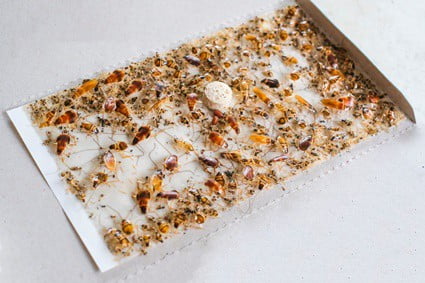
Do Glue Traps Work for Cockroaches?
Glue traps (also known as sticky traps) are a great way to catch a few roaches. The bugs will get stuck as they make their way through your home. The traps usually come in strips and are meant to be placed in common roach paths.
Before placing the strips, observe where roaches are frequently spotted if you don’t know already. A great way to discover this is by looking for roach poop. Cockroaches leave waste as they walk around. If there are droppings, cockroaches have traveled down that path.
The main advantage of glue traps is their placement. Cockroaches won’t steer from their path, even if an unfamiliar object is placed in front of it. Many glue traps have a hint of bait, but it’s not enough to attract a large number.
Sadly, glue traps are great for monitoring cockroach infestations, not controlling them. The bait in glue traps isn’t very potent, and some brands don’t even mix the bait with pesticides. As such, there’s no guarantee that the cockroach will die quickly.
Glue traps can also become futile when too many roaches become stuck on them. If your infestation is severe, you’ll need to replace the traps constantly. This is time-consuming and expensive if it’s the only cockroach-trapping method you’re using.
How to Make Homemade Cockroach Traps
If you’re trying to save money, cockroach traps can be made at home. It’s not recommended to attempt poison bait with pesticides, however. These can be highly toxic and damaging when mishandled.
Because of this, most of your traps will not kill the cockroaches outright. The infestation will have to be dealt with differently.
Still, trapping and killing just one cockroach can prevent the birth of hundreds. Even non-lethal traps should be made and placed around the home. Here are some easy, homemade traps that are highly effective against roaches:
Homemade Glue Traps
Mix some glue and sugar, and place it in front of cockroach hotspots. Make sure to do this when the cockroaches are most active, which is usually during the night. The cockroaches will be attracted to the sugar and get themselves stuck in the glue.
The only problem with this is how fast the glue can dry. To make sure cockroaches get to it quickly, cease all the activities in your home and turn off all the lights. Roaches dislike light and are more likely to forage when there aren’t humans around.
Duct Tape Traps
Much like the homemade glue trap, you can place some sugar, peanut butter, or any other kind of food on top of some duct tape. This will attract cockroaches until they get stuck in the trap.
If you have an ant problem as well, do this at night when cockroaches are most active. Too many ants can get stuck in the trap and render it useless before the cockroaches even arrive.
Beer Trap
Cockroaches are huge fans of beer due to the amount of sugar it contains. Dip a small cloth in beer and place it inside a jar. The sugar will attract cockroaches, but the alcohol will stun them momentarily.
The alcohol might not be enough to kill the cockroach outright, but it will be enough to leave it immobile for a while. This gives you enough time to kill it however you see fit.
Roach traps can work well, but make sure you choose the right type, know how to place them, and customize them to the species.
